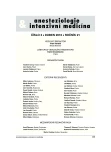Xenon inhalational anaesthesia in volunteers
Authors:
Török Pavol 1; Hermely Albert 1; Sopko Imrich 1; Čandík Peter 1; Saladiak Stanislav 1; Sýkora René 1; Májek Milan 2
Authors‘ workplace:
OAIM VÚSCH, a. s., Košice
1; KAIM SZU, FNsP – Dérerova nemocnica, Bratislava
2
Published in:
Anest. intenziv. Med., 21, 2010, č. 3, s. 134-139
Category:
Anaesthesiology - Original Paper
Overview
Objective:
We describe the first experimental administration of xenon inhalational anaesthesia in volunteers. The primary aim was administering a short inhalational xenon anaesthesia and learning the technique and technology of its administration. The secondary aim was observing objective physiological and laboratory parameters and the subjective feelings of the subjects who had undergone the anaesthesia.
Setting:
Department of Anaesthesia and Intensive Medicine.
Design:
Clinical experiment (Approval No. 21082009 of the Ethical Committee).
Materials and methods:
The objective effects of xenon anaesthesia on the physiological variables and laboratory tests and its subjective perception until the loss of consciousness by the subjects were tested in a group of 5 volunteers. Two subjects reached the first two depth levels of anaesthesia and the remaining subjects reached levels 3 and 4 of xenon anaesthesia. All the subjects were monitored and managed in a standard fashion.
Results:
The laboratory tests were performed prior to and 15 minutes after the anaesthesia. There were no significant differences found in the results before and after the anaesthesia. No result exceeded the normal range. Blood pressure and heart rate were stable, without significant changes, during the course of anaesthesia. Ventilatory parameters showed minor changes, the heart rate decreased and breathing became temporarily deeper but after reaching anaesthesia depth-levels 3 and 4, all the parameters became normal again. SpO2 was stable, oscillating between 97 and 100%, ETCO2 reached 4.6–5.2 kPa. The authors evaluated the subjective perception by the anaesthetized persons at the moments when xenon concentration in the airways reached a relatively stable concentration at 10, 20, 30, 40 and 50%.
Conclusion:
This experiment is one of the first ones in the field of gaining technical skills and experience in performing xenon anaesthesia. For the volunteers, all of whom are anaesthetists, this was a unique personal experience. The authors expect early implementation of xenon anaesthesia into their clinical anaesthetic practice in indicated cases.
Keywords:
xenon– inhalational anaesthesia
Sources
1. Virtue, R.V. Minimal flow N2O anaesthesia. Anaesthesiology, 1974, 40, p. 196–198.
2. Larsen et al. Anestezie. Grada publishing: Praha, 2004, p. 903.
3. Török, P. Monitorovanie počas anestézie a na OAIM. In: Firment et al. Základy anesteziológie. LF UPJŠ: Košice, 2001, p. 302.
4. Török, P. Inhalačná anestézia – súčasný stav. Možné a potrebné technické riešenia v SR s výhľadom integrácie do EÚ. Materiál výboru SSAIM pre MZ SR, 2000, s. 4.
5. Bamert, J. H., Falter, F., Eletr, D. et al. Xenon anaesthesia may preserve cardiovascular function in patients with heart failure. Acta Anaesthesiol. Scand., 2005, 49, p. 743–749.
6. Baumert, J. H., Hecker, K. E., Hein, M. et al. Effects of xenon anaesthesia on the circulatory response to hypoventilation. British Journal of Anaesthesia, 2005, 1, p. 166–171.
7. Baumert, J. H., Hein, M., Hecker, K. E. et al. Autonomic cardiac control with xenon anaesthesia in patients at cardiovascular risk. British Journal of Anaesthesia, 2007, 5, p. 722–727.
8. Bedi, A., McBride, W. T., Armstrong, M. A. et al. Xenon has no effect on cytokine balance and adhesion molecule expression within an isolated cardiopulmonary bypass system. British Journal of Anaesthesia, 2002, 3, p. 546–550.
9. Burov, N. E, Korienko, L. JU., Džabarov, D. A., Mironova, I. I. Gemodinamika i funkcia myokarda pri xenonnoj anestezii. Anesteziologia i Reanoimatologia, 1993, 5, p. 57–59.
10. Burov, N. E, Korienko, L. JU., Džabarov, D. A., Mironova, I. I. Vlijanie anestezii ksenonom na morfologiu i svertyvajuščuju systemu krovi. Anesteziologia i Reanoimatologia, 1993, 6, p. 14–18.
11. Burov, N. E., Korienko, L. JU., Makaev, G. N., Potapov, V. N. Kliničesko experimentaľnoe issledovania anestezii xenonom. Anesteziologia i Reanoimatologia, 1999, 6, p. 56–60.
12. Burov, N. E., Korienko, L. JU., Makaev, G. N., Potapov, V. N. Alternatvnoe sposoby udeševljeni anetezii xeonom. Anesteziologia i Reanoimatologia, 1997, 4, p. 71–73.
13. Burov, N. E., Korienko, L. JU., Makaev, G. N., Potapov, V. N. Anesezia xenonom, sostojanie i perspektivy primenenia v chirurgii. Annaly chirurgii, 1998, 4, p. 60–64.
14. Burov, N. E., Potapov, V. N. Xenon v prektičeskoj anesteziologii, Sostojanie i perspektivy primenenija v Rosii. V zborníku: Xenon i xenonsberajuščie technologii v medicine – 2005. Moskva, 2005. p. 57–62.
15. Kozlov, I. A., Voronin, S. V. Xenon pri operaciach na serdce-kačestvcenno novyj variant obščej anestezii. Zdravoochranenie i medicinska technika, 2004, 10, p. 10–12.
16. Kozlov, I. A. Izofluran a Xenon v anesteziologii. Vestnik intensivnoj terapii, 2003, 3, p. 23–29.
17. Kozlov, I. A., Chubutia, A. S., Voronin, S. V. Pervyj opyt s anesteziej xenonom pri operacijach s iskustvennym krovoobraščeniem. Serdečno sosudnyje zabolevanija, 2003, 6, p. 125.
18. Goto, T., Nakata, Y., Morita, S. Will xenon be a stranger or a friend? The cost, benefit, and future of xenon anesthesia. Anesthesiology, 2003, 98, p. 1–2.
Labels
Anaesthesiology, Resuscitation and Inten Intensive Care MedicineArticle was published in
Anaesthesiology and Intensive Care Medicine

2010 Issue 3
Most read in this issue
- Multiple organ dysfunction syndrome (MODS) – from molecules to the bedside
- Xenon inhalational anaesthesia in volunteers
- Sugammadex (Bridion®) – our first experience with the reversal of moderate rocuronium-induced neuromuscular block
- N-terminal pro-Brain natriuretic peptide (NT-proBNP) in acute brain disease: Elevated serum levels without sodium imbalance
